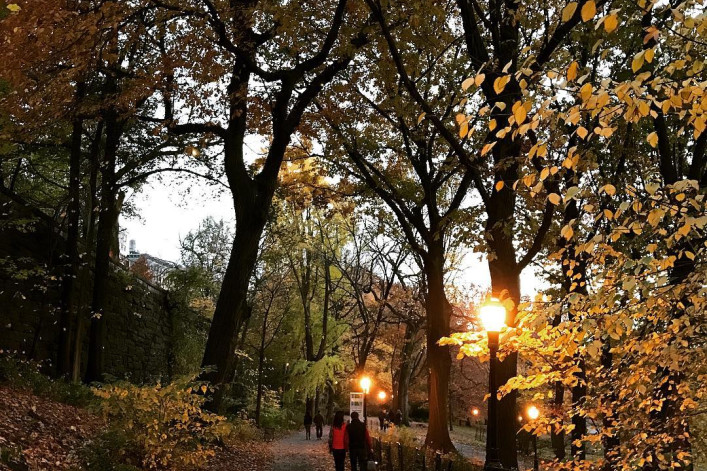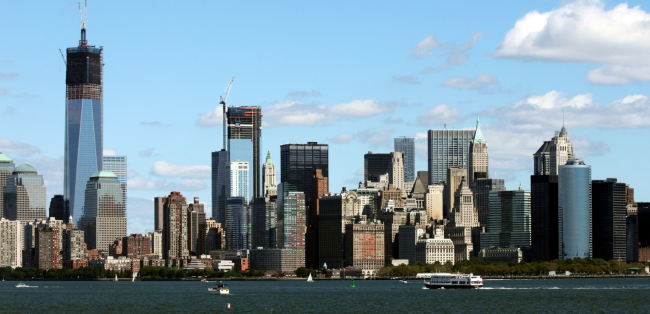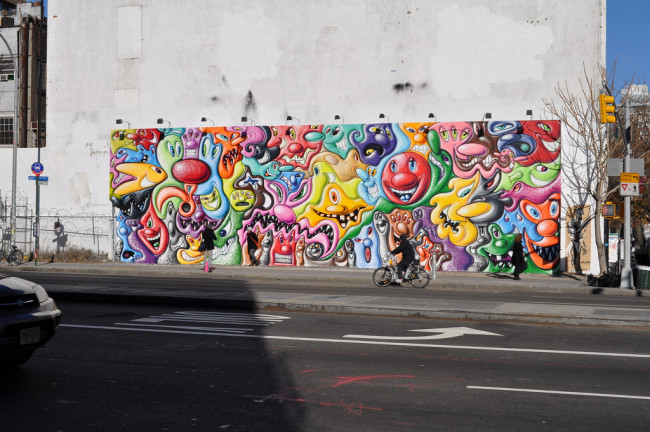Celebrating what IS great-—or could be-—about NYC

S. Jhoanna Robledo
In a recent essay for the New Yorker, Jia Tolentino writes, “It’s in the nature of years to feel exhausting in retrospect... But 2016 does seem to have earned some sort of special designation.” She catalogues the myriad tragedies that have unfolded over the past 12 months, but quickly follows with some perspective-taking, pointing out that there’s no shortage of dark eras throughout human history. “Hope is elusive, but it will return eventually,” Tolentino writes.
New Yorkers can’t really be blamed if we’re feeling a bit bleak these days: The cost of housing is imperiling our finances, artists are wondering whether they should pack it in entirely, supertalls are threatening to blot out the sky, and throngs of reporters, protestors, and curious onlookers around Trump Tower are rendering a stretch of the city impassable.
But is it really all bad news? Author and native New Yorker Pete Hamill once characterized NYC as “always changing, evolving, building. Sometimes for the better, sometimes not. The city’s enduring slogan could be: Get on with it, my friend.”
Now, at the start of 2017, we’d like to focus the many ways the city continues to give hope, or, as it were, is “getting on with it.”
Immigrant New York gets extra protection
Jeremiah Moss—who shares a name, not coincidentally, with the Old Testament’s “weeping prophet”—has long been tracking the city’s vanishing landmarks, many of which have been forced out of business to make way for new developments.
Plenty of New Yorkers share Moss’ dismay at the mounting losses, and some are working to preserve the places that give neighborhoods their character. Andrew Berman, executive director of the Greenwich Village Society for Historic Preservation, says he feels heartened by a major, recent success: After a 10-year campaign led by the GVSHP, the Landmarks Preservation Commission voted unanimously to landmark a final segment of the Village.
The area comprises ten blocks south of Houston Street, between Sixth Avenue and West Broadway. “That’s a part of town that probably would have been destroyed by development,” Berman says. The neighborhood includes spots like the St. Anthony of Padua church, the oldest extant Italian-American church in the country, which features striking Romanesque Revival architecture.
Another now-protected spot is Vesuvio Bakery, a shop that has been around for over a century; Forgotten New York deems its preserved storefront one of the city’s most iconic. On the residential side, this southern stretch of the Village is home to 19th and early 20th century tenements—many of them with their original cast-iron façades still intact—built by an Italian-American fraternal organization to help their compatriots find quality housing.
“The area is saturated through and through with wonderful immigrant history,” Berman says. “These days more than ever, it’s important to show the contributions that immigrants have made to our city and our country, and say that this is something we’re proud of. There’s value in highlighting that history, and preserving what we should learn from that time and that experience.”
The city is also taking steps toward protecting its present-day immigrants. The New York Times reports that both Mayor Bill De Blasio and Governor Andrew Cuomo—who are ordinarily at odds—have said in the wake of Donald Trump’s election that NYC will remain a sanctuary city—that is, a city where law enforcement is limited from prosecuting undocumented immigrants.
Urban areas throughout the country began designating themselves as sanctuaries in the late 1970s, but doubling down on the policy is significant now, given that the president-elect has vowed to block funding, per CNN, to these cities. De Blasio said that he would legally challenge a federal Muslim registry, while Cuomo promised to vigorously protect the rights of immigrants of all faiths throughout the state.
The city grows greener
New York City, at least in Forbes’ estimation, is the “world capital for the ultra-rich.” But even though NYC has more billionaires than any other metropolis on the planet, 2016 was nevertheless a year in which the city invested heavily in something that’s free to all: its parks.
The Parks Department has set aside $150 million for five parks, one in each borough, to give the green spaces that serve an estimated 750,000 people substantial upgrades. One of those parks is Staten Island’s Fresh Kills, the former landfill turned vast green space, which is opening in phases and will be complete in 2036.
On Governor’s Island, meanwhile, this summer saw the debut of The Hills, a new public space that offers the necessary height for stunning skyline views—not to mention several long slides for young and old New Yorkers alike to enjoy. And in December, reports the Brooklyn Daily Eagle, the city obtained the last bit of land needed to create Bushwick Inlet Park, a project over ten years in the making.
There was good greenspace news in the Bronx, too: A new initiative called the Haven Project will make it easier for thousands of South Bronx residents to enjoy the outdoors by creating waterfront parks and making it easier to access Randall’s Island.
Finally, the Parks Department is working to get New Yorkers active by making outdoor activities more affordable and accessible, says Crystal Howard, director of media relations. The fees for adult tennis permits have been cut in half, and in 2017, the department will add 75 more classes to Shape Up NYC, its free drop-in fitness program.
New developments that aren’t cookie cutter
Additions to the NYC skyline clearly aren’t always embraced with open arms: Consider the criticism hurled at 432 Park Avenue, a luxury residential supertall that Fortune calls “the house that inequality built,” and whose design, The Real Deal reports, was literally inspired by a garbage can.
That said, 2016 did bring us some new developments that are aesthetically appealing, and offer amenities and conveniences to New Yorkers beyond the one percent.
This year, the Oculus—a transit hub-cum-365,000-square foot mall—opened downtown to some plaudits; Gothamist admired the structure’s “sculptural grace,” comparing its strikingly spiky exterior to the quills of a porcupine.
Santiago Steele, a broker with Citi Habitats, has been struck by the interiors, too. “One of the things that you think about with new developments in New York are glass-and-steel high rises, identical boxy buildings with no character and no activity,” he says. “But here, there’s an underground communal space that links all these different things—food, shopping, art, the 9/11 museum—plus ten subways and the PATH train. It’s actually pretty incredible.”
Though some—like one writer at The Verge—see the $4 billion structure as a symbol of bureaucratic wastefulness, others consider it emblematic of the city’s comeback from disaster.
“There was originally a mall there that was destroyed in 9/11, so there’s an element of resurgence to it,” Steele points out. “It’s an interesting way to revitalize the city—it gives you a lot of explore as a New Yorker.”
Shelly Place, who represents neighborhoods in Manhattan and Brooklyn for Citi Habitats, says she’s looking forward to coming changes to the Lower East Side. The Lowline, for instance, the Highline’s underground counterpart, will debut in a former trolley terminal below Delancey Street in 2020, but parts of it are already open to the public. The solar-powered park space will feature food, events, educational workshops, and community events.
“I don’t know of any other city that has done anything quite like this,” Place says.
She also has high hopes for the Essex Crossing development, set to bring public gardens, residences, office space, restaurants, retail, and a revamped Essex Street Market to the LES.
Place acknowledges fears about “the dreaded g-word,” gentrification, stirred up by these looming changes to a traditionally immigrant neighborhood. but she thinks the new properties will honor the LES’ character. (According to Curbed, the residential development at Essex Crossing will include 500 affordable units.)
“[The developers] are trying to keep the Lower East Side true to what it’s known for: a lot of cultural, food-oriented, and art-oriented spaces,” Place says. “Sometimes with developments, you wonder, ‘Why are they tearing that down?’ But I’m genuinely excited for what’s going to happen with this.”
More resources for creative New Yorkers
In 2010, Patti Smith told artists that NYC was no longer a viable place for the young and creative to set down roots. Seven years later, New York’s writers, artists, and performers are still wrestling with the question of whether they should stay or go. Some arts institutions have voted with their feet and headed to cities where the rent is far more reasonable, like the Galapagos Gallery, which relocated to Detroit.
Others, though, are seeking out more affordable corners of NYC. Crain’s recently declared the Bronx the city’s new arts hub, at the center of which is the Bronx Museum of the Arts, currently engaged in a $25 million expansion. The Bronx Documentary Center, meanwhile, is a nonprofit that engages the local community in photography and filmmaking. Recently, its collaboration with Fujifilm has brought to a broad audience images taken by locals, which capture the borough in all its variety and complexity.
Still, being able to pay the rent isn’t exactly getting easier for artists. One organization that aims to help NYC creatives thrive is the New York Foundation for the Arts, which provides awards, grants, fiscal sponsorship, and plentiful information on where to find jobs and other sources of financial support. NYFA has also launched new initiatives that bring the work of underrepresented artists to the fore—and help them make a living.
Michael L. Royce, NYFA’s executive director, cites the organization’s Arts Business Incubator, for cultural entrepreneurs who are supporting artist communities, as a promising development. “In 2016, we selected our second cohort of startups, and we match them with the experts they need—accountants, lawyers, media specialists—for free,” he says.
Among this year’s winners are a production company supporting emerging filmmakers from underrepresented communities, an online destination that makes art accessible to millennial collectors, and a storybook app for children.
NYFA also curates corporate offices, including those of real estate brokerages, with pieces by local artists. “All the works are from artists that live and work in NYC. We bring their work to the attention of corporations, put their works on their walls, and they sell,” Royce says.
Many other non-profits are focused on supporting local artists, as well as enriching the city’s cultural landscape. The city’s Department of Cultural Affairs offers a thorough list of all the organizations working to help artists here; you’ll find places like The Lower Manhattan Cultural Council, which provides creative New Yorkers with both money and space through its grant-giving and residency programs.
Last June, WNYC spoke to artists about whether they thought it was time to give up on NYC. One Brooklyn photographer on the verge of moving to North Carolina explained, “I never rest in New York. I always feel like I have to be doing something work-related.”
But the segment also includes a Laurie Anderson song, in which she yearns for the cheaper days in which New York artists could truly make headway—the 1960s.
So is this moment really the time to find a new place, as Patti Smith suggested? Perhaps—but maybe that new place is actually within the “always changing, evolving, building” New York City itself.
You Might Also Like






























